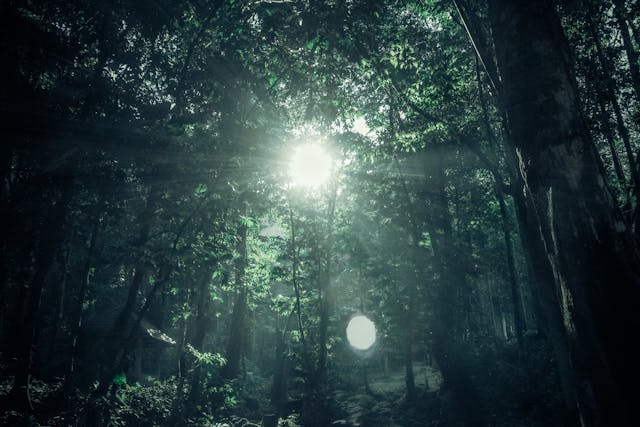Today, we’re exploring something every adventurer should know: surviving alone in the jungle. Whether you’re hiking through dense tropical forests or find yourself lost in unfamiliar wilderness, knowing how to handle the situation could save your life. Let’s walk through the crucial steps for staying safe.
Step 1: Stay Calm and Assess Your Situation
Breathe First, Act Second: The first thing to do when you realize you’re lost is simple but vital—don’t panic. Take a few deep breaths to calm your nerves and clear your head. Anxiety leads to poor decisions, and you’ll need your wits about you in a jungle setting.
Survey Your Surroundings: Slowly take in your surroundings. Are there any natural landmarks? Can you hear running water, or see any animal tracks? This is valuable information for later decisions.
Step 2: Remember Your Basics: Shelter, Water, and Food
Surviving in the jungle revolves around meeting three key needs: shelter, water, and food. Let’s break each down.
Shelter
Build a Simple Shelter: Your first priority is to create a safe, dry place to rest. Rain, heat, and cold can hit you hard in the jungle. Look for natural shelters such as large trees with buttress roots, caves, or dense foliage that offers coverage. If nothing suitable is available, you can create a lean-to by using branches and large leaves to form a roof. Make sure you’re away from animal paths or potential hazards like falling branches.
Water
Locate Freshwater: Water is more critical than food in the short term, and dehydration can be a serious threat. Look for streams, rivers, or natural pools. If you can’t find a clear water source, collecting rainwater is your best bet. Large leaves can be used to funnel rain into a container, or even a depression in the ground.
Make a Solar Still: If you’re unable to find drinkable water and the jungle floor is too dry, a solar still can help extract moisture from the ground or plants. Here’s how to make one:
- Step 1: Dig a hole about 2 feet deep in a sunny spot.
- Step 2: Place a container in the center of the hole to catch water.
- Step 3: Cover the hole with a plastic sheet (if you have one) or large leaves, and weigh the edges down with rocks.
- Step 4: Place a small rock in the center of the sheet, so it dips over the container, and water will drip into it as it evaporates from the ground and condenses on the plastic or leaves.
While this is a slow process, it can provide some hydration in a pinch.

Food
Jungle Food: While you can survive for days without food, you’ll need energy to keep going. However, it’s vital to avoid eating anything you can’t confidently identify. The jungle is home to both nutritious and toxic plants, and eating the wrong thing could make your situation worse.
Fruits and Plants You Might Find:
- Coconuts and bananas are common in some tropical areas, but they’re more typical in coastal or cultivated regions than deep jungle.
- Look for bamboo shoots or heart of palm, which are edible and safe if you recognize them.
- Avoid berries altogether unless you are absolutely certain they’re safe.
When in doubt, it’s best to stick with plants that you know are safe or seek out protein-rich insects like ants, termites, or grubs, which are relatively safe sources of nutrients.
Step 3: Signal for Help
Create a Signal: It’s essential to signal for help as soon as possible. If you hear helicopters or planes, use anything shiny (a mirror, a metallic object) to reflect sunlight toward the sky if there’s a break in the canopy. This is one of the most effective ways to catch a pilot’s eye.
Ground Symbols: In dense jungle, creating large symbols on the ground may not be seen easily through the thick canopy, so only do this if you find an open space, like a riverbank, or a clear break in the trees. Creating large letters such as “SOS” using stones or branches is a good method in open areas.
Bright Clothing: If you’re wearing brightly colored clothing, position yourself in any clearings or open ground where it can be easily spotted from above.
Step 4: Stay Put if Possible
Avoid Wandering Aimlessly: Staying in one location increases your chances of being found. If you need to move to find water or a better shelter, do so carefully, but make sure you leave clear markers behind (such as broken branches or stacked stones) in case you need to return or rescuers are searching for you.
Step 5: Protect Yourself from Jungle Hazards
Mosquitoes and Other Insects
Mosquito Protection: One of the biggest nuisances and potential health risks in a jungle is mosquitoes, which can carry diseases like malaria or dengue fever. If you don’t have insect repellent, you can use mud or cover your skin with long leaves to minimize exposed areas. Avoid stagnant water where mosquitoes breed.
Other Insect Threats: Ants, leeches, and other small insects can also become a problem. Use mud as a natural barrier for leeches, and check your body regularly to remove any before they become a bigger issue.
Avoid Wildlife Interaction
Stay Away from Animals: The jungle is home to countless creatures, many of which are not interested in you—unless you invade their space. Instead, maintain distance and avoid sudden movements around wildlife.
Dealing with Larger Animals: If you encounter larger animals like jaguars or boars, stay calm and back away slowly. Never run, as it can trigger a chase instinct in predators.

Step 6: Keep a Positive Attitude
Mental Strength: Survival isn’t just about physical actions—it’s a mental challenge. Keeping your spirits up can make all the difference. Staying busy by building shelter, gathering food, or improving your signals for help will give you a sense of purpose and stave off despair.
Step 7: Prepare for Nightfall
As night approaches, the jungle can become even more challenging to navigate and survive. Here’s what you should do when the sun starts to set:
Build Your Shelter Before Dark
Finish Your Shelter Early: Don’t wait until nightfall to finish building your shelter. Make sure it’s sturdy, provides protection from rain and insects, and is on higher ground to avoid any unexpected flooding or crawling creatures. Use leaves, branches, and vines to create insulation and coverage.
Stay Warm and Dry
Prevent Hypothermia: Even though jungles are warm during the day, temperatures can drop significantly at night, especially if it rains. Stay as dry as possible by using your shelter to block moisture. You can line the ground with leaves or grasses to avoid sleeping directly on the cold earth.
Avoid Moving After Dark
Stay Put: Once darkness falls, avoid moving through the jungle. It’s easy to become disoriented or injured in low visibility. Instead, stay near your shelter where it’s safer, and conserve your energy.
Make a Fire if Possible
Build a Small Fire: If conditions allow, build a small fire. Fire not only provides warmth and light but also helps deter animals and insects. Gather dry wood and kindling during the day, and use friction (if you have the skills) or natural resources to start the fire. If a fire isn’t possible, focus on insulating yourself with leaves, grass, or any available materials.
Be Mindful of Nocturnal Animals
Listen to Your Surroundings: The jungle is more active at night, with many animals becoming nocturnal. Listen carefully and stay alert to nearby sounds, but remember that most animals will avoid you if you don’t disturb them. Keep your shelter area clean and avoid leaving food that might attract creatures.

Conclusion:
Surviving in the jungle is all about prioritizing shelter, water, and safety. Protect yourself from the environment, stay hydrated, and make yourself visible to rescuers. Use your energy wisely, and above all, keep calm and stay positive. A well-prepared mindset can turn a challenging situation into a story of survival.
Thanks for stopping by GertieBlu! Stay safe, stay prepared, and enjoy your adventures—wherever they may take you! 😄









